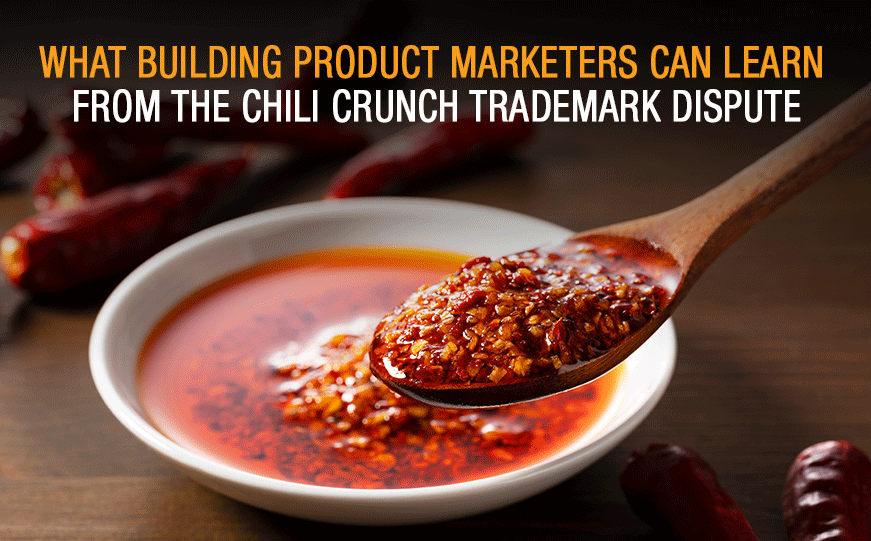The world of gourmet food recently witnessed a heated debate with implications far beyond the kitchen.
Celebrity chef David Chang – founder of the Momofuku restaurant group – attempted to trademark the term Chili Crunch. This move sparked outrage as chili crisp has long been a staple condiment in many cuisines. It’s also a popular pantry essential for a host of popular recipes.
Momofuku argued the distinct nature of their product justified the trademark.
However, the backlash highlighted the fine line between protecting intellectual property. And stifling culinary heritage.
For B2B product brands, this controversy is not limited to the food-prep mindset. Instead, the challenge offers valuable lessons for navigating the complexities in positioning unique selling opportunities. As well as intellectual property protection… for Building Product brands.
The Challenge: Balancing Innovation and Respect
At the core of the Chili Crunch conflict lies the tension between innovation and respect for existing traditions. Brands innovate constantly, introducing new products and improving existing ones. However, overzealous brand protection can inadvertently claim ownership of generic terms – or concepts – thereby alienating audiences.
Consider Apple’s early attempts to trademark the term “App Store.” Yes, as you might imagine, the company eventually lost the case. After all, the initial push sparked concerns about Apple stifling competition in the mobile app ecosystem.
Of course particular business niches can contain a number of big players in them. Consider The Home Depot and Lowes. Ideally, big players got that way through their own efforts.
It’s another thing all together for one or more dominant brands to conspire in order to stifle competition or crush current or future challenger brands.
These examples highlight the importance of striking a balance. Protecting unique brand elements (logos, slogans) is crucial. Yet marketers must proceed with caution. All brands – and challenger brands in particular – have to temper trademark protection with an understanding of other market forces.
Building Strong B2B Brands: A Recipe for Success
So, how can brands and those involved with building material sales navigate this uneven territory?
- Focus on Distinctive Innovation: Momofuku’s Chili Crunch might have a unique flavor profile or production method. So instead of the generic term – a trademark application for a specific packaging – trade dress, or production process could have been a stronger strategy.
A good example is DuPont’s Kevlar®. While aramid fibers existed before DuPont, the company’s unique manufacturing process – and brand identity – solidified the brand as the destination for high-strength, heat-resistant performance promises. - Community Engagement: Building Product brands operate in tight-knit and recognized communities. Proactively engaging with industry stakeholders and potential customers in those platforms helps to foster understanding and to build trust.
Industry leading distributor, PrimeSource Building Products, provides a great example for leveraging community engagement. Their customers have the opportunity to enroll in a rewards program called PremierClub. Every year, PrimeSource hosts a three-day event at a different high value resort destination, the PremierClub Experience. Premier Club members who qualify are recognized, and invited to enjoy top-tier entertainment, celebrity chef-inspired cuisine and legendary grand prize packages. This fosters a mutually rewarding sense of loyalty. While providing the brand a unique forum to better understand diverse customer needs. - Transparency and Communication: Clear communication regarding brand strategy builds trust. When Momofuku attempted to trademark Chili Crunch, a transparent explanation of their rationale – focusing on the unique aspects of their product – could have helped to mitigate public outcry.
- Respect for Established Concepts: Building Product brands often operate within established channels with well-defined terminology. Respecting these existing terms – and lingo – demonstrates an appreciation of the audience and avoids unnecessary conflicts.
Conclusion: Beyond the Chili Crunch
The David Chang Chili Crunch saga offers valuable lessons for B2B brands and building materials marketing. Striking a balance between innovation and respect for established concepts is crucial. By focusing on distinctive innovation, engaging with your community, communicating clearly and respecting existing frameworks… Building Product brands can build strong, sustainable reputations while safeguarding their intellectual property. Remember, a strong brand is more than just a trademark. Most importantly, it’s about fostering trust, understanding and creating value for customers and prospects. We cover all of these ideas in our white paper on Challenger Brands, which you can download here.
If you’re interested in balancing a unique selling position with all of the competing forces that a brand faces, we’re here to help. Send an email to Steve at sk@kleberandassociates.com to get the conversation started.




